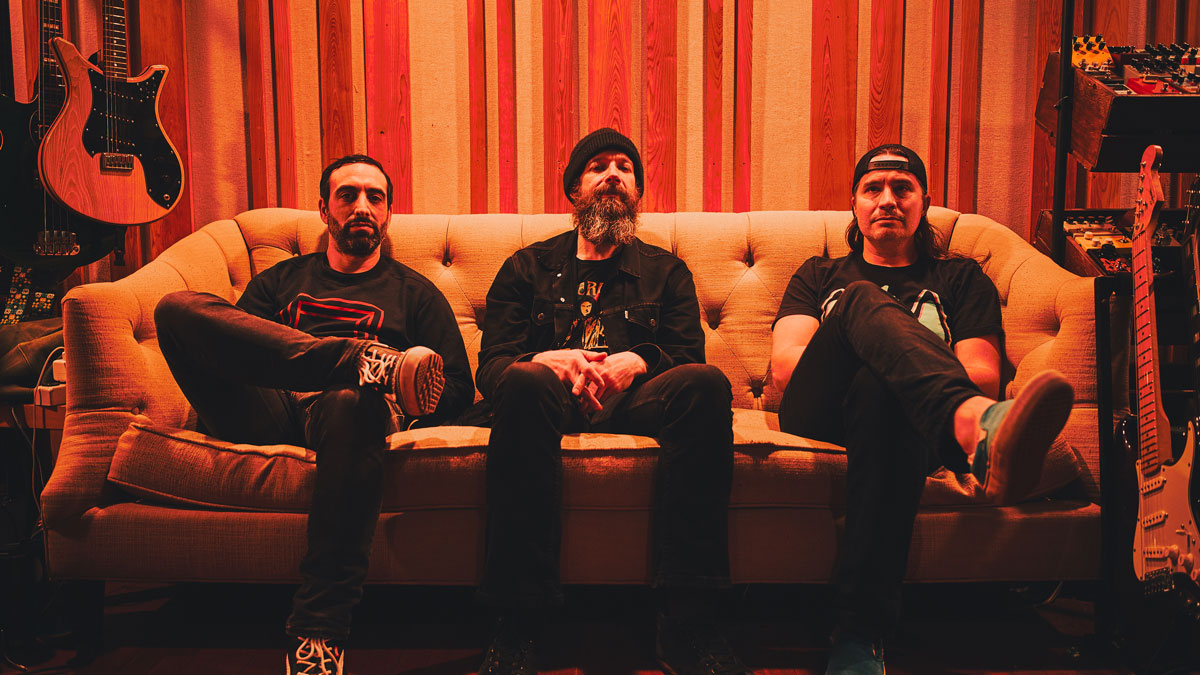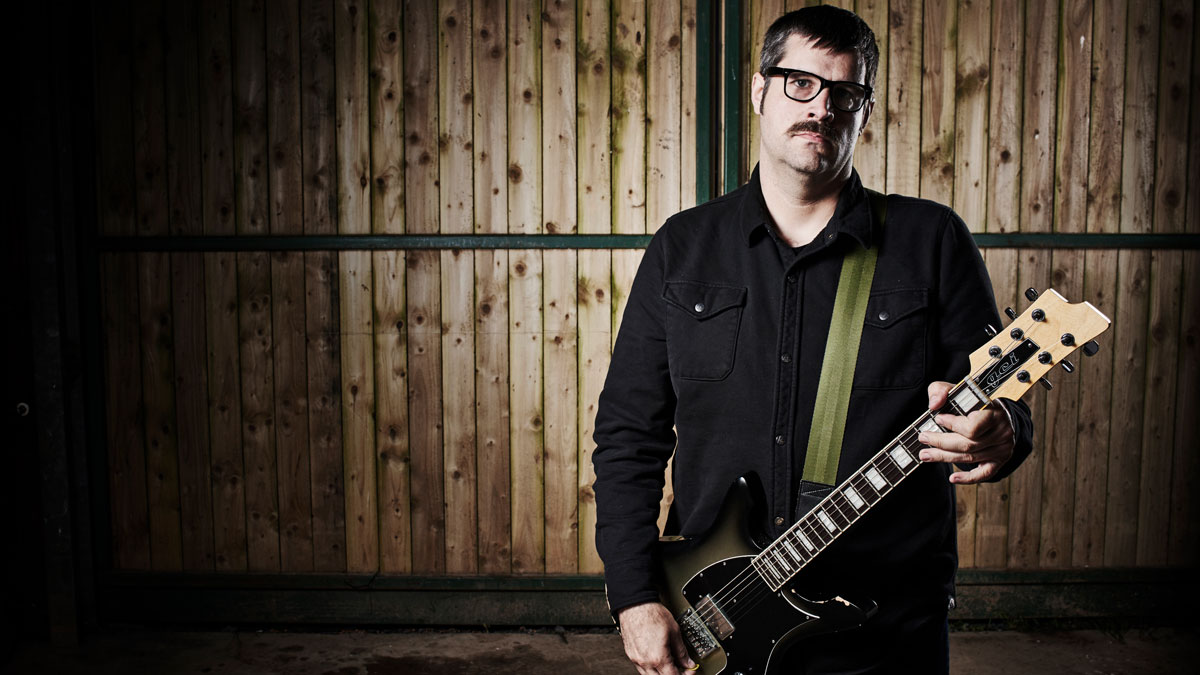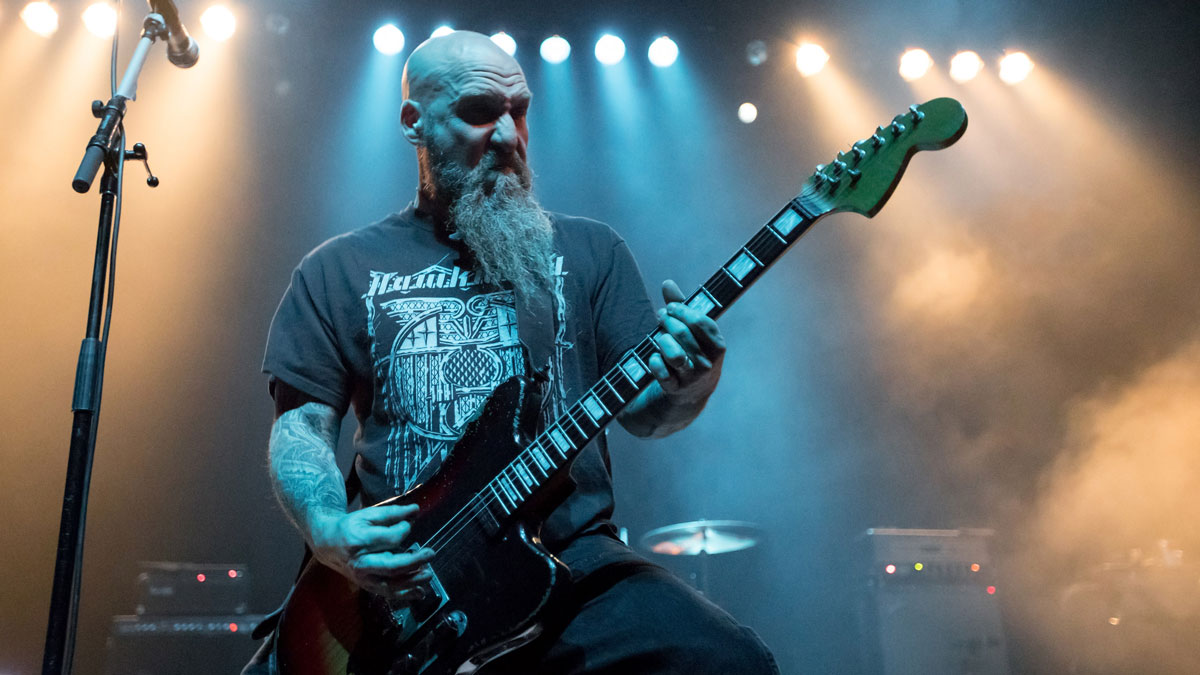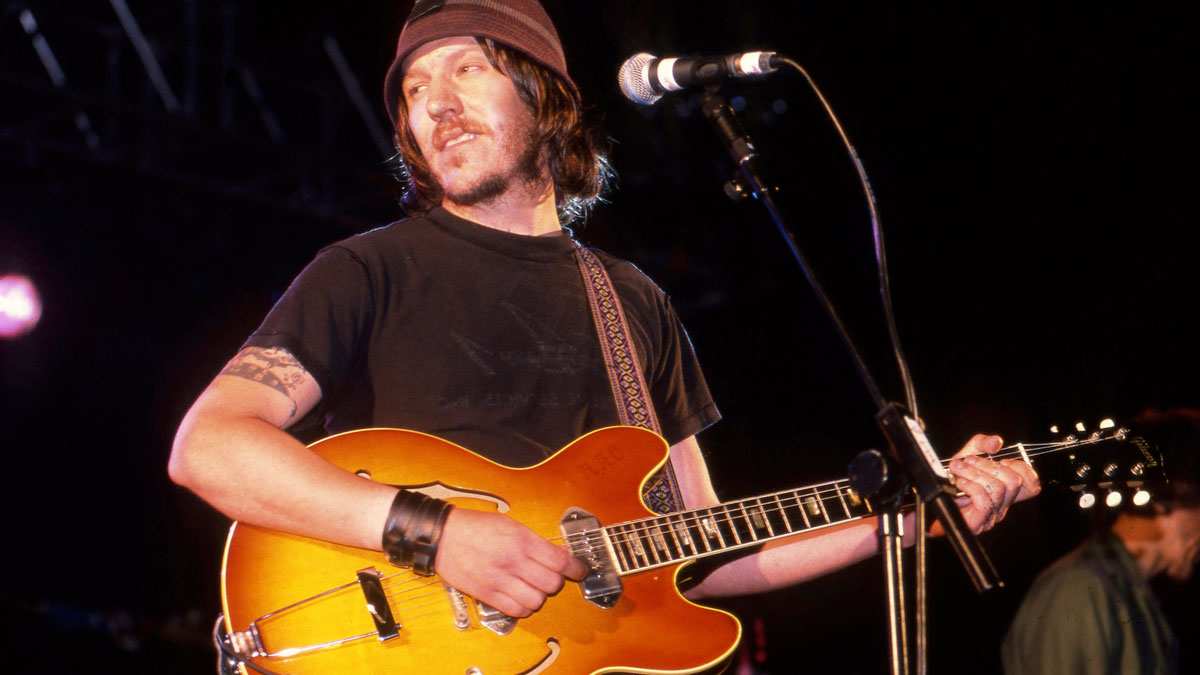
Just like the rest of us, Mutoid Man guitarist Stephen Brodsky dove deep into the Van Halen catalog following Eddie’s death in the fall of 2020. The Massachusetts-raised musician explains to Guitar World that around that time, he started filling out his vinyl collection with key releases from the revolutionary hard rockers.
While Brodsky confesses the lighting-quick lickin’ he surges into Setting Son – the final track from Mutoid Man’s upcoming Mutants album – might sport a bit of EVH in its DNA, it took the guitarist a long time to build up the flashiest elements of his own style.
“I always put [Eddie Van Halen] in this unattainable category of guitar playing – something that I love to listen to, more than a style that I necessarily wanted to emulate, [at least] as a young guitar player,” Brodsky says, though that eventually changed.
“It’s fun to tap into that approach, especially early Van Halen where the rhythm playing goes right into the lead, and then the lead jumps back to rhythm: one seamless performance. I love that! There’s that type of approach in mind [on Mutants]. Being that Mutoid Man is a single guitar band, it gives it this sort of lively feeling – something dangerous and real.”
Brodsky’s impressive riff-ography dates back to the mid-‘90s, when he co-founded trailblazing metal hybridists Cave In as a teenager. Since then, he’s explored anything from hardcore to space rock with that wide-reaching outfit, but in recent years he’s also supplied gloom-groove rhythm riffin’ to Converge’s epic Bloodmoon: I album; became a touring guitarist with post-hardcore icons Quicksand; and has now returned with the first Mutoid Man release in six years. With that sonic breadth in mind, it’s fitting that the hardware sometimes shifts between his various projects.
For the pensive, brooding approach of something like Cave In’s Heavy Pendulum (2022), Brodsky may reach out for a thick and meaty Les Paul, his love for the Gibson classic instilled in him by his father at a young age.
The toxic fluorescence of Mutoid Man’s Mutants, meanwhile, is a more tempo-jolted effort, with Brodsky gleefully shredding quick-fingered runs and pull-off motifs above the frantic pace of the rhythm section of Converge drummer Ben Koller and High on Fire bassist Jeff Matz. You could argue that heightened sense of sonic ostentatiousness is complemented by the boldly pointed countours of one of Brodsky’s V's.
Earlier in the band’s career, Brodsky had been wailing on a black-and-white Aria Pro II that Mutoid Man’s original bassist, Nick Cageao, found for him on Reverb; these days, Brodsky’s firing up the fretboard of a Dunable Asteroid.
“It really dawned on me that those things are absolutely built for speed,” Brodsky explains of his affinity for a slippery V. “There’s just so much space in the upper neck region; there’s really nothing in your way to do whatever you want to do up in that space.”
Van Halen may have inspired the most high-velocity moments of Mutants, but many of Brodsky’s formative guitar heroes are hyper-local, stemming from the hardcore scene he burst out of nearly three decades ago. From octave innovators and stompbox wizards, to a penpal from an underrated mid-west emo band, to riffers with a taste for the dangerous, these are the guitarists who helped shape Brodsky’s sound.

1. Phil Brodsky
“That’s my dad, and that’s how it started for me. As a young man, my dad played in a band called the Discords. They didn’t really get much further outside of Dorchester, Massachusetts. [Regardless,] there was always a guitar of his kicking around the house where I grew up.
“I got serious about wanting to play late in seventh grade, and very early on, I can remember my dad helping me through the chord changes of Guns N’ Roses’ Patience. That became my mantra for learning guitar, because by nature I’m a very impatient person. Once I was able to glue those chords together – even at a slower bpm than the original song – this door opened for me. It went to a place where it didn’t matter that I was terrible at sports, or had zero confidence in talking to girls.
“When I started to play [guitar,] it reinvigorated his love of playing. So, he made a midlife crisis kind of purchase on a pretty Les Paul. After a few years of playing, he saw that I was really devoting myself to it, and for Christmas one year I came downstairs and the Gibson Les Paul guitar case was under the Christmas tree with my name on it. I have to start with my dad, because I honestly don’t know how, when, or even if I would’ve found this path that I’m on without his love and support, and his affection for rock and roll.”
2. Adam McGrath (Cave In)
“It’s probably not a surprise to anyone that he’s on this list, but Adam’s really come a long way since the early days of Cave In. I’ve been fortunate to witness that progression in him firsthand.
“Adam is the definition of reliable. It’s kind of like that Bob Dylan lyric: ‘I’ll know my song well before I start singing’. I feel like that sums up Adam’s approach to things, and his general sense of dedication to the band. He’s very grounded, sensible, methodical – I mean, he was a Boy Scout as a kid, if that gives you any indication of where his vibe comes from.
“There’s been numerous times I’ve shown him something I’m working on, and in the process of him digesting it, his interpretation ends up being the more grounded and sensible way of playing it. That’s super-helpful for me, because my brain can run infinite ways with an idea, almost to my detriment. I need those weights to anchor me to a place where [a riff is] of practical use.
“Also, his effects pedal game is stronger than ever now, since he’s gotten into reggae and dub music. He’s this formidable stompbox wizard, and just an all-around fantastic human being.”
3. Jim Martin (Faith No More)

“He’s a fantastic player, but I want to talk about his tone a bit. The next time you listen to The Real Thing or Angel Dust, pay attention to when the guitar kicks in. Usually, there’s this tiny squeal of feedback right before he comes in – it sounds like the whole thing is about to take off at any moment, and just start howling like a motherfucker.
“In my head, I’m imagining Jim positioned right next to his amplifier while he’s tracking this stuff. The whole thing has this edge to it, and it gets me every time. I’d say that tone has inspired me to always invite this element of sonic danger into the mix.”
4. Adam Jones (Tool)
“Adam Jones is the reason I started playing in drop B. When Undertow came out, my ear was developed enough to identify things like pitch, and sometimes alternate tunings. [That said,] I’ll never forget when Prison Sex came on. I was convinced that it was a bass for those first few seconds of the song, but when the little tags come in at a much higher register, it made my head spin. Like, ‘What the fuck am I listening to right now?’
“Some of Cave In’s most popular songs are in drop B; with the exception of two songs, the entirety of the Mutoid Man catalog is in drop B. When Mutoid Man first started, we were a two-piece – it was just me and Ben Koller; our name [at the time] was Narcoleptic Beetle. We were just fucking around in a rehearsal space trying to figure out what was going on, and playing in drop B was this cheap, affordable way for us to sound like we had a bass player. And let’s be real: everything sounds better in drop B. Thanks, Adam Jones!”
5. Kurt Ballou

“Honestly, I was on the fence about hardcore before discovering Converge. I would have happily stayed in my little ‘90s alterna-grunge bubble, but Kurt’s innovation and playing style changed all that. I got sucked in pretty damn hard. I mean, it all goes back to the first record, [1994’s] Halo in a Haystack.
“[Kurt] had this super-unique midrange tone. I think he was playing an Ibanez. He’s the type of person that would kill me for assuming something that was completely off-the-mark, but I do know for a fact that he was playing through a Traynor amp. I didn’t know anybody who was playing through a Traynor amp back then, let alone in hardcore punk.
“The band had a mystique. The song arrangements had these crazy sorts of rollercoaster storylines. There was an element of what we now call ‘riff soup’, which is [where] you’re not hearing parts repeat. This [philosophy] was all new to me, though. I studied Halo in a Haystack for a year straight. It set the bar for the sense of musical adventure that I wanted to hear out of underground hardcore.
“Kurt and I later became friends, and I joined Converge for a year and a half and we worked on a record together [1998’s When Forever Comes Crashing]. Since then, we’ve worked on [numerous] music projects. You know, just becoming friends with one of the smartest, most innovative guitar players that I’ve ever met is a real treasure.
“Because [Converge] was pushing themselves to the next level at that time [during Brodsky’s initial tenure with the band], the music was getting wilder, heavier, more metallic, noisier, meaner. Now I’m in the rehearsal space with these guys, and I’m wrapping my head around this shit on bass. Everything that I knew about Halo in a Haystack was becoming primal by comparison, [and] it got to the point where I would pick up a guitar and my ‘Converge bass fingers’ would make the guitar feel like a toy.
“As a result, [that] was filtered back into the writing process for Cave in. The musical DNA of [Cave In’s 1998 debut album] Until Your Heart Stops was heavily inspired by and fueled by my time in Converge, for sure.”
6. Travis Shettel and Aaron Stuart (Piebald)
“I’m singling out Travis because he wrote the early Piebald stuff that just floored me, but Travis and Aaron Stuart [were] very big inspirations on myself and Cave In, just [in] the way [they] played off each other. [Piebald] was one of the first major kinships Cave In [struck up] in the world of hardcore – we were about the same age, and approaching hardcore music with a similar mindset.
“[Piebald] was a two-guitar band that created things that were worth emulating, and worth paying attention to, like the way they used octave chords. I mean, we’d heard Fugazi use octave chords, but Piebald were harmonizing them; they were doing ping-pong stereo effects with riffs; and doing this in odd time signatures, as well.
“At their shows, they’d also make a point to fall down on the floor and flail with reckless abandon, [and] that was exciting! I’d never seen shit like that before. We brought that into Cave In, a little bit. Getting to know those guys at such a formative age, their songwriting pushed Cave In in a certain way.”
7. Scott Hobart (Giants Chair)
“Scott is the guitar maestro for Giants Chair, a three-piece band. They took the chord voicings of Rush, and reimagined it with the blunt force of Fugazi. It was incredibly ear-pleasing to me, right off the bat. Listening to that band in high school gave me these sonic hallucinations of underground music in the Midwest [Giants chair are from Kansas City, MO – Ed]: what it sounded like, and what it felt like. I wanted to use that to expand the vocabulary of what was happening around me on the East Coast, in my little world of mid-to-late ‘90s hardcore punk.
“I also became penpals with Scott around that time, and I would ask him all kinds of questions about his guitar playing. He would graciously send me back handwritten notes with chord charts to their songs; I still have those stashed away somewhere. It was fun in those instances to see how he might be doing something, versus what my ear was telling me. The whole thing was a great learning experience. Any chance I get to talk about Giants Chair, I love doing it. I feel like it’s a band that is severely under-the-radar. More people should spend time with them.”
8. Steve Von Till (Neurosis)

“Much like with Adam Jones, hearing Neurosis made me experiment with playing in drop A. That’s the heavy shit, you know? A whole step lower than Tool! Actually, lots of stuff on Cave In’s Heavy Pendulum record [from 2022] was written in drop A.
“We’re always going to be chasing Neurosis as a live band. The way those guys completely surrendered themselves to playing music on stage with this volcanic level of energy….it almost seems too dangerous for anyone else to even try to match. That shit was frightening, especially [the songs from 1996’s] Through Silver in Blood. These guys were just these shadowy, ominous figures on stage blowing the fuck out of the PA speakers.
“Steve’s contributions to the band resonate with me, in particular. He brought the wet effects to the guitar playing, the textures and the nuance he drizzled over all that cool dirgy shit. He was the guy that I would stand in front of at Neurosis shows.
“Any sort of open chugging that doesn’t require my left hand, I’ll put that in the category of ‘thank you, Neurosis!’
9. John McLaughlin
“One word that comes to mind when I think of John McLaughlin is ‘sinister’. He has this ability to play as delicate and graceful as a painting of a pair of sleeping doves, and then the next thing you know their wings burst into flames! That shit is just scorching hell upon you, with some of the most sick and twisted melodic choices. I get confused all the time trying to find the one in all the shit that guy does. He’s my guide [towards embracing] the more beautifully strange possibilities of writing guitar music.
“His element of surprise is so keen; it strikes me like a good twist in a horror movie. A great example is Sanctuary off [Mahavishnu Orchestra’s 1973 record] Birds of Fire – it’s like The Exorcist of jazz fusion. Its horrifying, but masterfully done with jazz chops, and it’s very rock and roll. If you’ve never heard this record [but] you can appreciate shredder music, oh my God it’s going to fuck you up.”
10. Elliott Smith

“This might seem like a curveball choice, but he’s the reason I became interested in fingerpicking. As far as his fingerpicking style goes, that shit is way too elusive for me to really sink into and replicate, but it sucked me in. Ultimately, that’s what inspired me to choose a path to just do my own thing with fingerpicking.
“I always knew that he was a badass guitar player – I’d seen him pay a few times: once solo, and twice with a band – but it wasn’t until I started learning fingerstyle [that I could] fully appreciate the freakish nature of this guy’s hybrid form. It’s folk, flamenco, Texas shuffle, a little bit of Delta blues, classical, rock, and I’m probably forgetting a few things, too. It’s just so mutated and cool.”
- Mutants is out on July 28 via Sargent House.







